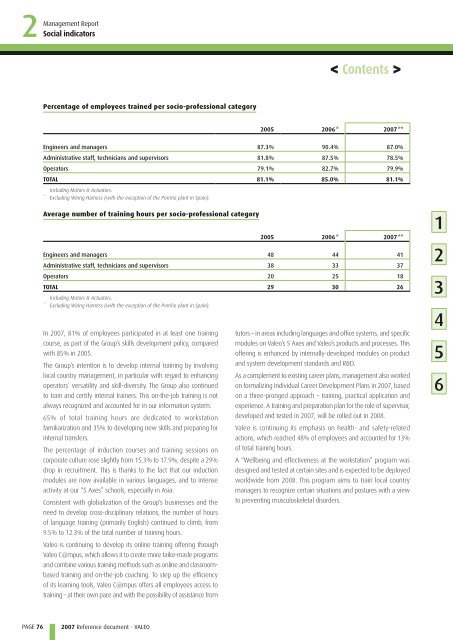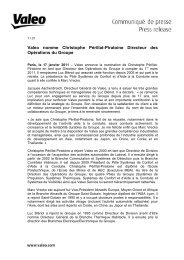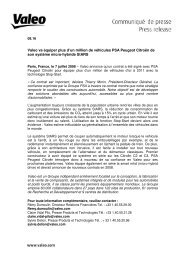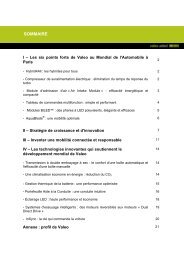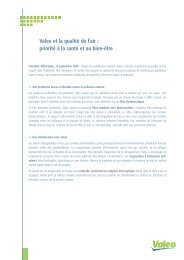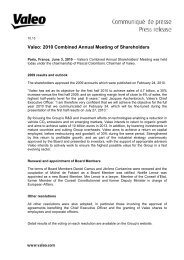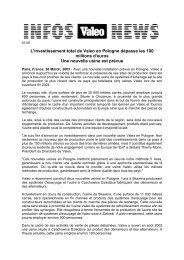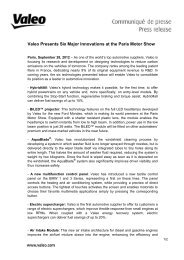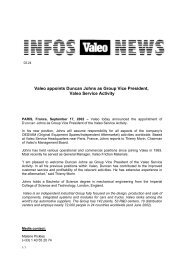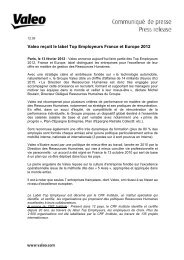2007 Reference document (PDF) - Valeo
2007 Reference document (PDF) - Valeo
2007 Reference document (PDF) - Valeo
You also want an ePaper? Increase the reach of your titles
YUMPU automatically turns print PDFs into web optimized ePapers that Google loves.
2 Management<br />
PAGE 76<br />
Report<br />
Social indicators<br />
Percentage of employees trained per socio-professional category<br />
<strong>2007</strong> <strong>Reference</strong> <strong>document</strong> - VALEO<br />
2005 2006 * <strong>2007</strong> **<br />
Engineers and managers 87.3% 90.4% 87.0%<br />
Administrative staff, technicians and supervisors 81.8% 87.5% 78.5%<br />
Operators 79.1% 82.7% 79.9%<br />
TOTAL 81.1% 85.0% 81.1%<br />
* Including Motors & Actuators.<br />
** Excluding Wiring Harness (with the exception of the Porriño plant in Spain).<br />
Average number of training hours per socio-professional category<br />
2005 2006 * <strong>2007</strong> **<br />
Engineers and managers 48 44 41<br />
Administrative staff, technicians and supervisors 38 33 37<br />
Operators 20 25 18<br />
TOTAL 29 30 26<br />
* Including Motors & Actuators.<br />
** Excluding Wiring Harness (with the exception of the Porriño plant in Spain).<br />
In <strong>2007</strong>, 81% of employees participated in at least one training<br />
course, as part of the Group’s skills development policy, compared<br />
with 85% in 2005.<br />
The Group’s intention is to develop internal training by involving<br />
local country management, in particular with regard to enhancing<br />
operators’ versatility and skill-diversity. The Group also continued<br />
to train and certify internal trainers. This on-the-job training is not<br />
always recognized and accounted for in our information system.<br />
65% of total training hours are dedicated to workstation<br />
familiarization and 35% to developing new skills and preparing for<br />
internal transfers.<br />
The percentage of induction courses and training sessions on<br />
corporate culture rose slightly from 15.3% to 17.9%, despite a 29%<br />
drop in recruitment. This is thanks to the fact that our induction<br />
modules are now available in various languages, and to intense<br />
activity at our “5 Axes” schools, especially in Asia.<br />
Consistent with globalization of the Group’s businesses and the<br />
need to develop cross-disciplinary relations, the number of hours<br />
of language training (primarily English) continued to climb, from<br />
9.5% to 12.3% of the total number of training hours.<br />
<strong>Valeo</strong> is continuing to develop its online training offering through<br />
<strong>Valeo</strong> C@mpus, which allows it to create more tailor-made programs<br />
and combine various training methods such as online and classroombased<br />
training and on-the-job coaching. To step up the efficiency<br />
of its learning tools, <strong>Valeo</strong> C@mpus offers all employees access to<br />
training – at their own pace and with the possibility of assistance from<br />
< Contents ><br />
tutors – in areas including languages and office systems, and specific<br />
modules on <strong>Valeo</strong>’s 5 Axes and <strong>Valeo</strong>’s products and processes. This<br />
offering is enhanced by internally-developed modules on product<br />
and system development standards and R&D.<br />
As a complement to existing career plans, management also worked<br />
on formalizing Individual Career Development Plans in <strong>2007</strong>, based<br />
on a three-pronged approach – training, practical application and<br />
experience. A training and preparation plan for the role of supervisor,<br />
developed and tested in <strong>2007</strong>, will be rolled out in 2008.<br />
<strong>Valeo</strong> is continuing its emphasis on health- and safety-related<br />
actions, which reached 48% of employees and accounted for 13%<br />
of total training hours.<br />
A “Wellbeing and effectiveness at the workstation” program was<br />
designed and tested at certain sites and is expected to be deployed<br />
worldwide from 2008. This program aims to train local country<br />
managers to recognize certain situations and postures with a view<br />
to preventing musculoskeletal disorders.<br />
1<br />
2<br />
3<br />
4<br />
5<br />
6


